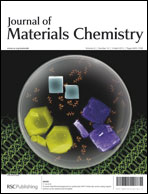Irreversible and reversible chromatic transitions during heating and cooling cycles were investigated in polydiacetylene poly-PCDA (poly-10,12-pentacosadiynoic acid) composites with nanocrystalline zinc oxide (ZnO), titanium oxide (TiO2), zirconium oxide (ZrO2) and ZnO and ZrO2 alloys. In contrast to pure poly-PCDA, poly-PCDA composites with nanocrystalline ZnO displayed rapid reversibility on thermal cycling, whereas the corresponding composites with nanocrystalline TiO2 and ZrO2 were irreversible, and poly-PCDA composites with thermally prepared ZnO and ZrO2 alloys displayed slower reversibility. The mechanism of reversible and irreversible thermochromism in these materials was explored using Raman spectroscopy, Fourier transform infrared spectroscopy (FTIR), differential scanning calorimetry (DSC) and X-ray absorption fine structure (XAFS) spectroscopy. In pure poly-PCDA, heating leads to an irreversible strain on the polymer backbone to form a red phase, which is not released on cooling. In the presence of ZnO evidence is provided for chelation involving the side chain head groups which can release strain on cooling to rapidly form the blue phase. Chemical interaction coupled with reversible behavior was however observed only when the composites were prepared with ZnO having an average crystallite size of 300 nm and below with a fraction of an amorphous grain boundary phase. Poly-PCDA composites with ZnO/ZrO2 alloys showing slower thermochromic reversibility can be used both as temperature and elapsed time-temperature sensors.

You have access to this article
 Please wait while we load your content...
Something went wrong. Try again?
Please wait while we load your content...
Something went wrong. Try again?


 Please wait while we load your content...
Please wait while we load your content...